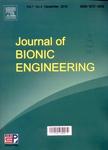Structural-Nanomechanical Property Correlation of Shallow Water Shrimp (Pandalus platyceros) Exoskeleton at Elevated Temperature
Structural-Nanomechanical Property Correlation of Shallow Water Shrimp (Pandalus platyceros) Exoskeleton at Elevated Temperature作者机构:School of Aeronautics and Astronautics Purdue University West Lafayette IN 47907 USA
出 版 物:《Journal of Bionic Engineering》 (仿生工程学报(英文版))
年 卷 期:2014年第11卷第3期
页 面:360-370页
核心收录:
学科分类:0710[理学-生物学] 0831[工学-生物医学工程(可授工学、理学、医学学位)] 090801[农学-水产养殖] 0908[农学-水产] 08[工学] 09[农学] 080502[工学-材料学] 0805[工学-材料科学与工程(可授工学、理学学位)] 0836[工学-生物工程] 0702[理学-物理学]
基 金:Acknowledgment Authors would like to thank Dr Ming Gan for help with the nanoindentation. Also authors would like to acknowledge the excellent technical assistance of Dr. Christopher J. Gilpin Chia-Ping Huang and Laurie Mueller with the SEM. Authors also acknowledge support from the National science Foundation Grant CMMI1131112 (Program Manager: Dr. Dennis Carter)
主 题:fresh water shrimp nanomechanics temperature dependence creep mechanism
摘 要:This investigation reports the nanomechanical properties of shallow water shrimp exoskeleton at temperatures ranging from 30 ℃ to 80 ℃ measured using nanoindentation experiments. Scanning Electron Microscopy (SEM) measurements suggest that the shrimp exoskeleton has the Bouligand structure in its layers, a key characteristic of the crustaceans. The thickness of the layers and packing density are found to be different from that of lobsters and crabs reported earlier in the literature. Mechanical properties at high temperatures are determined using micro materials nanoindentation test set up combined with the hot stage. The properties measured during nanoindentation test are corrected for the creep and thermal drift during the experiments. The reduced modulus values are found to be around 28 GPa at 30 ℃ that reduces to approximately 24 GPa at 80 ℃. The hardness values also decrease from 1.6 GPa at 30 ℃ to around 1.2 GPa at 80 ℃. The indentation size effect is found to be absent at all temperatures. Creep mechanisms of polymers like materials and its temperature dependence are discussed to give more insight into the deformation mechanism.



